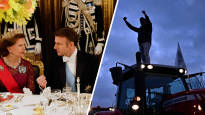the president of France Emmanuel Macron and this wife Brigitte Macron the state visit to Sweden is talked about on social media.
Macron attended a gala dinner with Swedish royalty on Wednesday as people protested high diesel and fertilizer prices and inflation outside Paris.
What social phenomenon is the pair of pictures trying to make visible?
On Wednesday evening, the King of Sweden Charles XVI Gustav and the queen Silvia received the French president in their Stockholm castle.
The reception was part of Macron’s two-day visit, which had previously been postponed.
The crown princess also attended the reception Victoriaher consort prince Daniela prince Carl Philip and the princess Sophia.
On Wednesday evening, pairs of pictures started to appear on social media: the first picture showed Macron in a tuxedo, surrounded by crystal glasses and royals. The second picture showed tractors, bonfires and people on the highway.
Although the images are usually ambiguous, the pair of images of Macron and farmers do not need an explanatory text to be understood, says the professor of sociology Eeva Luhtakallio from the University of Helsinki.
– The picture could be interpreted as a certain kind of metaphor for inequality in society. It plays with diversity in the most blatant way possible, says Luhtakallio.
While Macron and his spouses were enjoying classic French dishes such as clams in Stockholm’s Royal Castle, French protesters were frying sausages along the highways outside Paris.
Social media in updates the French have expressed their indignation at Macron, who had traveled to Sweden for a state visit despite the unrest in France.
In the video, French farmer Bertin Moret shares his own view of what the protest movement wants to achieve.
What was annoying about the president’s tuxedo?
On social media and during protests, Macron has been accused of indifference to the plight of French farmers.
In Sweden, Macron mainly spoke about the importance of Sweden’s NATO membership, and did not take a stand on the protests in his home country.
This is how Macron commented on agricultural policy at a press conference in Stockholm on Tuesday. Macron promised to promote regulation of food imports in the European Union.
In addition to the price of diesel and fertilizers, agriculture in Europe is burdened by many other problems that have eroded the profitability of agriculture and weakened farmers’ earnings.
For example, harvests weakened by extreme weather events, government budget cuts and EU political decisions, such as the customs exemption granted to Ukrainian grain, affect the wages of farmers across Europe.
In addition to France, farmers have protested in, for example, Germany, Belgium and Poland.
According to Luhtakallio, photo pairs of politicians have been made before, but Macron’s visit to Sweden was visually interesting and offered a delicious setting.
– The president was sitting in a tuxedo and next to the Queen of Sweden, Luhtakallio states.
Macron’s tuxedo alone hardly caused irritation, but the photo pairs were probably created as a reaction to earlier events, the expert thinks.
The pictures summarize the citizens’ long-simmering frustration with Macron and his attitude to the protests, Luhtakallio estimates.
– Macron is also known internationally for his indifferent attitude towards civic activities, and he had a contemptuous attitude towards the yellow vest protests.
The movement born in 2018 has opposed the worsening conditions of the middle class and the rise in taxes and the cost of living in France.
Can humor and memes influence politics?
On the same night that Macron dined with Swedish royalty, AI-generated images illustrating the elitism of the French political leadership were uploaded to social media.
According to Luhtakallio, in a world of growing inequality, the question of whose voice will be heard is increasingly central.
– The strengthening of the power of the image is part of today’s public, where the tyranny of algorithms often rules, but where virality is always possible. Images are often used even by small-scale actors, for whom they are an effective way to make their voices heard
You can also use humor and memes to convey a political message that otherwise wouldn’t get across.
For example, right-wing populists often use images to avoid having to verbalize their ideology.
– The words printed in slogans can get caught and be guilty of defamation, Luhtakallio explains.
Images, on the other hand, are ambiguous and it is more difficult to prove defamation with them.
According to the researcher, image pairs can be used in many ways as tools of visual politics.
For example, in Finland, the Elokapina movement has equated the Kaisaniemi protests with the police violence on the UC Davis campus in the United States.
In 2012, the Occupy movement, born out of the lack of perspective of the financial crisis, held a demonstration in the courtyard of a California college. During the protest, the police used, among other things, pepper spray against harmless activists.
Movements opposing climate change, on the other hand, often use pairs of images that illustrate, for example, the situation of glaciers or coral reefs in different periods.
The intertwining of politics and money is criticized with the help of pictures
The influence of images as a means of political influence has increased significantly in recent years, because all the images in the world are now on a smartphone in your pocket.
According to Luhtakallio, pictures can be used as many kinds of arguments, and they are used to make politics even without words or without them.
– Images are changing the rules of public discussion and the selection of means. Their meanings may be conflicting, but they can’t be ignored, and they don’t necessarily need words to support their settings.
The fact that the image can easily spread globally is also an indication of the power of the image. Unlike text, an image does not require language to be understood.
What thoughts did the article evoke? You can discuss topic 2.2. until 23:00.
